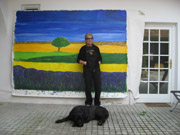Marianne Hasenöhrl-Obsieger




born 1945 in Elmstein / pfalz, germany Begins to work with clay under the tutelage of noted German sculptor, Käthe Burghardt. 1965-71 Academy of fine arts Vienna, studied architecture in the masterclass of Roland Rainer. Awarded Master's degree in Architecture, Academy of fine art Vienna. Working as architect in Vienna 25 years. From 1995 visiting classes (3D objects, Installations) in Salzburg Summeracademy founded by Oskar Kokoschka, as well as Painting Courses. Died 2023 in Bad Waltersdorf / Austria
In den Arbeiten von Marianne Hasenöhrl-Obsieger finden sich Elemente großformatiger Malerei wieder, ebenso wie Objektkunst, Rauminstallation und Performance.
Seit 1995 arbeitet sie intensiv an einer Lösung, die Malerei in den dreidimensionalen Raum zu erweitern. Anfangs versuchte sie das mittels Collagen zu verwirklichen, die sie im Laufe der Zeit zu Objektcollagen weiterentwickelte.
Der Hintergrund als Malerei verbindet sich übergangslos mit eingefügten Objekten. Teilweise seriell erzählt sie visuelle Geschichten. Als Ausgangsmaterial für ihre Arbeiten verwendet sie Puppen und andere kleinere Objekte, die einen persönlichen historischen Wert für sie haben und durch diesen Bezug eine Erweiterung der Kunst um die Person der Künstlerin darstellen. Diese gefunden Objekte stammen von ständigen Streifzügen auf Flohmärkten und Alteisenlagern. Wie ready mades werden sie in ihren Collagen inkorporiert.
Inhaltlich verwendet Marianne Hasenöhrl-Obsieger sie so, dass sie je nach Projekt Geschichten erzählen kann. Es sind dies zumeist persönliche Geschichten, die immer wieder Bezug auf Ihre Kindheit und Jugend nehmen. Dabei spielen populäre Alltagsgegenstände der damaligen westlichen Welt eine zentrale Rolle, da in Ihrer Jugend der „American Way of Live“ entdeckt und importiert wurde und die damalige westliche Welt sich der Konsumgesellschaft verschrieb. In Anlehnung an Kurt Schwitters stellen die von ihr eingesetzten, gefundenen Objekte und Alltagsgegenstände eine skulpturale Weiterentwicklung ihrer Collagen dar, wobei stets ein persönlicher Bezug dafür sorgt, dass die Schublade der „objets trouvés“ aufgebrochen wird und gefundenen Abfall oder Altwaren zu geliebten Fundobjekten mit Erinnerungswert macht.
In ihren neuen großformatigen Malereien versucht Marianne Hasenöhrl-Obsieger über das Format eine monochrome Stimmung mit einer Interpretation der Realität der strukturellen Malerei zu vereinen. Dabei hat sie keine Angst vor Farben. Diese werden Stimmungsträger Ihres Seelenzustandes und ein Fenster in Ihre innere Landschaft.
In the works of Marianne Hasenöhrl-Obsieger one can find elements of large scale painting as well as object art, spatial installation and performance art.
Since 1995 she has been working hard on finding a solution to expanding painting into three-dimensional space. She attempted to create this expansion at first with collages which she then developed into object collages in the course of time.
The painted background unites and aligns itself seamlessly with the inserted objects. Marianne Hasenöhrl-Obsieger tells visual stories, sometimes in serial sequence. As materials for her works she uses puppets and other small objects which have personal historic value to her and expand art by incorporating the artist herself. The “found objects” she uses come from constant forays into the world of flea markets and scrap metal yards. Like ready-mades, these objects they are integrated into her collages.
As regards content, Marianne Hasenöhrl-Obsieger uses these objects in such a way that she can tell stories with them which fit the project. These are mostly personal stories, frequently referring to her childhood and youth. In this, popular everyday objects of the past world play central parts: in her youth the “American Way of Live” was discovered and imported while the Western World embraced consumerism.
In the style of Kurt Schwitters the found objects of everyday life she uses depict a sculptural development of her collages, while there is always a personal connection that ensures the stereotyped box of “objets trouvés” is forced open and trash or junk she found is then turned into beloved finds and discoveries that have memory value.
In her new paintings, Marianne Hasenöhrl-Obsieger tries to unite a monochrome mood with an interpretation of the reality of structural painting by employing large scale formats. In doing this she is not afraid of colours. These become bearers of her spiritual condition and a window into her inner landscape.




